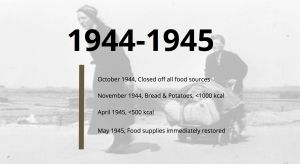Conclusion
The prevalence of chronic metabolic diseases such as obesity, insulin resistance and type 2 diabetes (T2D) is increasing at an unprecedented rate in modern day. Notably, T2D, despite its available treatments, is a leading cause of death. It is estimated that this number will increase over time. Type 2 diabetes is the result of reduced insulin sensitivity, preventing cells from absorbing glucose and resulting in high blood glucose levels [4]. It is commonly accepted that T2D is caused by both genetic and environmental causes. [4] Research conveyed that the genetic component of T2D is merely 5-10%, suggesting the major cause of T2D is the environment. [26] Furthermore, it is worthwhile to note intrauterine and neonatal nutrition and its implications in terms of metabolic syndromes such as obesity, insulin resistance and T2D. An example that depict nutrition deprivation during pregnancy is the Dutch Hunger Winter. [4]
Figure 1. Timeline of Dutch Hunger Winter
During the winter of 1944-1945, Germans were occupying The Netherlands. In early September 1944, The Netherlands’ allies liberated the majority of the Southern part of the country. In order to aid in further liberation, the Dutch government started a national railway strike in order to impede German military action. In response to this, in October 1944, the German government closed off all the food sources in the Western part of the country they still occupied. By November 1944, the rations merely included bread and potatoes and the average food intake was below 1000kcal per day; by April 1945, the food intake was as low as 500kcal a day (Figure 2). After liberation in May 5, 1945, food supplies were immediately restored (Figure 1). [27]
Figure 2. 500kcal of potato and bread
An interesting take from this unfortunate event was that it served as an natural experiment to illustrate the effects of intrauterine deprivation for the pregnant women who had been either in her early, middle or late pregnancy during the famine. It is especially striking for the food as been quite rapidly restored. In terms of birth weight, food deprivation of the pregnant mothers during the second or third trimester gave birth to babies with noticeably decreased birth weights; food deprivation of the pregnant mothers during the first trimester gave birth to babies with normal birth weights. However, these children born with normal birth weights were prone to have increased rates of obesity, altered lipid profiles and cardiovascular disease. In depth, children born with the influence of the famine in the third trimester of pregnancy continued to have smaller bodies throughout their life with decreased rates of obesity. [27]
Another notable finding was from the Siege of Leningard, where a similar situation happened with the Dutch Hunger Winter in that pregnant went through a famine from a food blockage by the German Army. Although The Netherlands had rapid food restoration, there was lasting food shortage situation in Leningard. The babies were born and was exposed to food deprivation—they did not show any signs of higher obesity or cardiovascular problems in adulthood. These two situations portray the fact that only when there is a catch-up growth after detrimental intrauterine conditions could bring metabolic syndromes. [28]
Figure 3. IGF2 DMR methylation among individuals periconceptionally
exposed to famine and their unexposed, same-sex siblings
An epigenetic implication to these data is that these children born with their mothers exposed to famine during pregnancy had a different DNA methylation state. For research suggests that methylation makers are stable till middle age, 6 decades after the famine, the children born during the Hunger Winter were examined for their DNA methylation state to see epigenetic indications. They were compared to their biological siblings who were not exposed to the famine at any time before or after birth to rule out genetic or family background. In particular, researchers looked into the IGF2 gene, which is an insulin-like growth factor 2 that is involved with physical development and growth. Results conveyed that the adults who went through the famine in utero had lower methylation of the IGF2 gene, even after 6 decades (Figure 3). [29] Moreover, it was interesting to find that children who were exposed to the famine in utero were more likely to have type 2 diabetes and impaired glucose tolerance during adulthood. This finding was also found in children born during the Chinese Famine (1959-1961) as well as Biafran Famine (1967-1970) [30].
In conclusion, exploring the domains of epigenetic through the lens of DNA methylation and other epigenetic pathways is powerful for developmentally and metabolically detrimental genes partially caused by environmental factors can be passed down to progeny.



November 12, 2017 at 8:40 pm
I like that there is an example of epigenetics occurring in the real world (as in not in experimentally controlled conditions). I think for the epigenetic implication paragraph, it’s important to clarify whether or not the methylation upregulated/downregulated expression of the IGF2 gene.
I would also include some background information on diabetes in general just to solidify the exact relationship insulin has with diabetes. Although epigenetics should be the primary focus, I think diabetes should be focused on as well (perhaps not to the same degree though). For instance, I think directly mentioning diabetes in the real-world examples given in this section would be helpful.